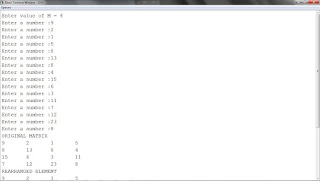[Question 2] ISC 2016 Computer Practical Paper Solved – Sorting Non-Boundary Matrix Elements
Question 2:
Write a program to declare a square
matrix A[][] of order (M x M) where ‘M’ must be greater than 3 and less
than 10. Allow the user to input positive integers into this matrix.
Perform the following tasks on the matrix:
(a) Sort the non-boundary elements in ascending order using any standard sorting technique and rearrange them in the matrix.
(b) Calculate the sum of both the diagonals.
(c) Display the original matrix, rearranged matrix and only the diagonal elements of the rearranged matrix with their sum.
Example 1(b) Calculate the sum of both the diagonals.
(c) Display the original matrix, rearranged matrix and only the diagonal elements of the rearranged matrix with their sum.
INPUT :M = 4
9 2 1 5 8 13 8 4 15 6 3 11 7 12 23 8 |
ORIGINAL MATRIX
9 2 1 5 8 13 8 4 15 6 3 11 7 12 23 8 |
9 2 1 5 8 3 6 4 15 8 13 11 7 12 23 8 |
9 5 3 6 8 13 7 8 |
SUM OF THE DIAGONAL ELEMENTS = 59
SOURCE CODE
import java.io.*;
import java.util.*;
class ISC2016_SortNonBoundary
{
public static void main(String args[])
{
int A[][],B[];
Scanner sc=new Scanner(System.in);
System.out.print("Enter value of M = ");
int M=sc.nextInt();
if(M<4 && M>10)
{
System.out.println("Invalid");
}
else
{
A=new int[M][M];
int N=(int)Math.pow((M-2),2);
B=new int[N];
//Loop for entering data
for(int i=0;i<M;i++)
{
for(int j=0;j<M;j++)
{
System.out.print("Enter a number :");
A[i][j]=sc.nextInt();
}
}
//Loop to find b[]'s element
int k=0;
for(int i=0;i<M;i++)
{
for(int j=0;j<M;j++)
{
if(i!=0 && j!=0 &&i!=(M-1) && j!= (M-1))
{
B[k]=A[i][j];k++;
}
}
}
//Loop to sort B[]
for(int i=0;i<N-1;i++)
{
for(int j=0;j<N-i-1;j++)
{
if(B[j]>B[j+1])
{
int k2=B[j];
B[j]=B[j+1];
B[j+1]=k2;
}
}
}
//Loop to print original data
System.out.println("ORIGINAL MATRIX");
for(int i=0;i<M;i++)
{
for(int j=0;j<M;j++)
{
System.out.print(A[i][j]+"\t");
}
System.out.println();
}
//LOOP TO REARRANGED MATRIXS
int arr[][]=new int[M][M];
int z=0;
for(int i=0;i<M;i++)
{
for(int j=0;j<M;j++)
{
if(i!=0 && j!=0 && i!=(M-1)&& j!= (M-1))
{
arr[i][j]=B[z];
z++;
}
else
arr[i][j]=A[i][j];
}
}
System.out.println("REARRANGED ELEMENT");
for(int i=0;i<M;i++)
{
for(int j=0;j<M;j++)
{
System.out.print(arr[i][j]+"\t");
}
System.out.println();
}
//Loop to form diagonal element
String ar[][]=new String[M][M];
int k3=0;
for(int i=0;i<M;i++)
{
for(int j=0;j<M;j++)
{
if(i!=0 && j!=0 && i!=(M-1)&& j!= (M-1))
{
ar[i][j]=String.valueOf(B[k3]);
k3++;
}
else
ar[i][j]=" ";
}
}
ar[0][0]=String.valueOf(A[0][0]);
ar[0][M-1]=String.valueOf(A[0][M-1]);
ar[M-1][0]=String.valueOf(A[M-1][0]);
ar[M-1][M-1]=String.valueOf(A[M-1][M-1]);
System.out.println("DIAGONAL ELEMENT");
for(int i=0;i<M;i++)
{
for(int j=0;j<M;j++)
{
System.out.print(ar[i][j]+"\t");
}
System.out.println();
}
//To find the sum of diagonal
int a=M-1,b=0,sum=0;;
for(int i=0;i<M;i++)
{
for(int j=0;j<M;j++)
{
if(i==j)
{
sum=sum+Integer.valueOf(A[i][j]);
}
if(i==b && j==a)
{
sum=sum+Integer.valueOf(A[i][j]);
a--;b++;
}
}
}
System.out.println("Sum="+sum);
}
}
}
OUTPUT
If you have any question then leave a comment below I will do my best to answer that question.
If you have any question then leave a comment below I will do my best to answer that question.




algorithm plz
ReplyDeleteThis comment has been removed by the author.
ReplyDeleteThank u for this program
ReplyDeleteHey this is Puneet here author of this blog. if you want any help regarding any of the question then you can just mail me.
DeleteThis is my email id " puneet.uttam.99@gamil.com "